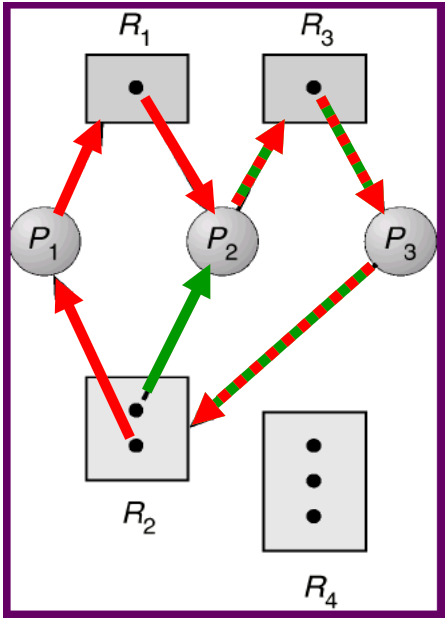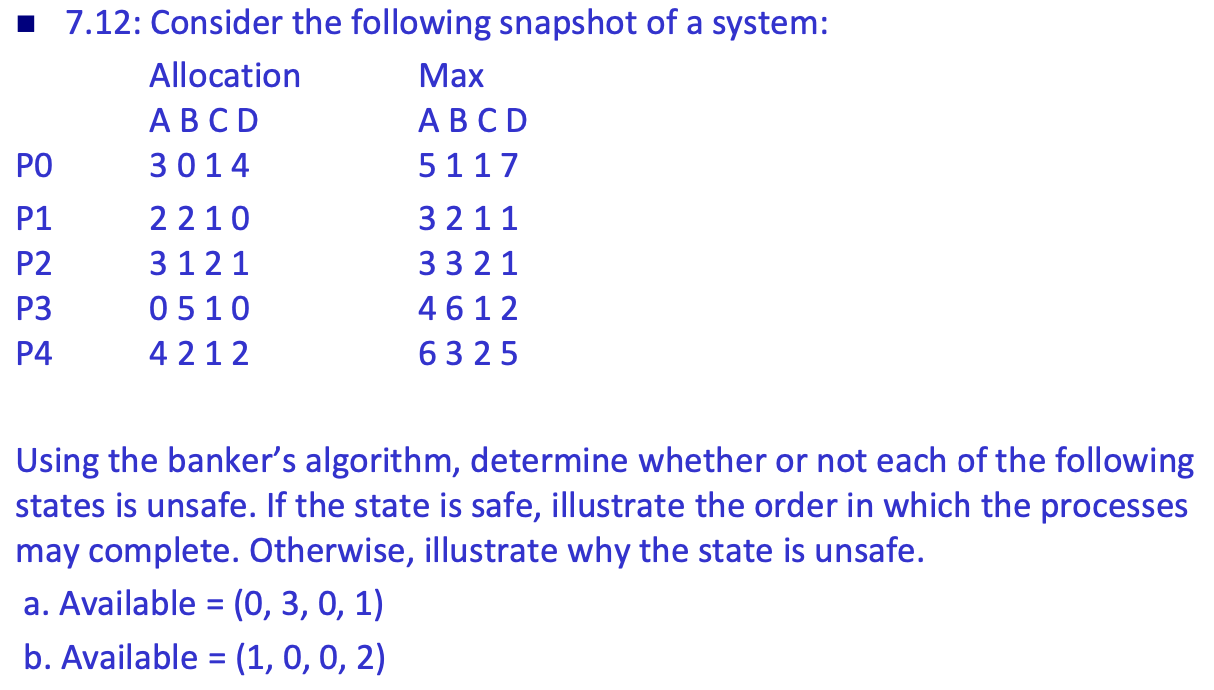[OS] Chapter 7 — Deadlocks
Deadlock Characterization
- Example
- 2 processes and 2 tape drivers
- 一人各拿一個,然後等對方手上那個
- 2 processes, and semaphores A & B
- P1 (hold B, wait A): wait(A), signal(B)
- P2 (hold A, wait B): wait(B) , signal(A)
- 2 processes and 2 tape drivers
Necessary Condition → 一定要全部的條件同時發生
Mutual exclusion — 資源是沒有共享性的(暫時)
Hold and Wait — 會 hold resource 然後 wait 別人
No preemptive — 不能強制別人放開 resource
Circular wait — 一定會有一個 circular 的 wait。
\(P_0 \rightarrow P_1 \rightarrow P_1 \rightarrow \dots\rightarrow P_n \rightarrow P_0\)

System Model
要有某些資源 \(R_1, R_2, \dots, R_m\)
- E.g. CPU, memory pages, I/O devices
每個資源 \(R_i\) 可能會有複數的共 \(W_i\) 個 instances
- E.g. a computer has 2 CPUs
每一個 process 取得 resource 的方式:
Request → use → release
Resource-Allocation Graph

- 3 processes, P1 ~ P3
- 4 resources, R1 ~ R4
- R1 and R3 each has one instance
- R2 has two instances
- R4 has three instances
- Request edges:
- P1 → R1: P1 requests R1 (一直存在因為 resource 正在被用)
- Assignment edges:
- R2 → P1: 那個 instance 正在被 P2 使用
⇒ P1 is hold on an instance of R2 and waiting for an instance of R1
- If the graph contains a cycle, a deadlock may exist
如果有 multiple instances,那就要檢查每一條路線都是 cycle 才行
Example 1

- P1 is waiting for P2
- P2 is waiting for P3 → P1 is waiting for P3
- P3 is waiting for P1 or P2, and they both waiting for P3
⇒ deadlock!
Example 2

- P1 is waiting for P2 or P3
- P3 is waiting for P1 or P4
- Since P2 and P4 wait no one
⇒ no deadlock
Deadlock Detection
- 沒 cycle → 沒 deadlock
- 有 cycle
- one instance per resource type → 有 deadlock
- multiple instances per resource type → 可能有 deadlock
Handling Deadlocks
- 確保不會進去
- deadlock prevention — 確保至少一個必要條件不會發生
- deadlock avoidance — 在 runtime 去不斷的檢查
- 讓他進去再 recover
- deadlock detection
- deadlock recovery
- 完全不處理(ignore the problem)
- 讓 user 去中斷他
Review Slides ( I )
- deadlock necessary conditions?
- mutual exclusion
- hold & wait
- no preemption
- circular wait
- resource-allocation graph?
- cycle in RAG → deadlock?
- deadlock handling types?
- deadlock prevention
- deadlock avoidance
- deadlock recovery
- ignore the problem
Deadlock Prevention & Deadlock Avoidance
Deadlock Prevention
- 每一種 resource 各拿掉一種條件。(每一個可以不一樣)
Mutual exclusion (ME): do not require ME on sharable resources
- E.g. set file to read only → no mutual exclusion (can many read in same time)
- 但不是所有都可以這樣解
- (Memory 是 support concurrent access 的,是 programer 的行為讓他有 ME 的條件出來的)
Hold & Wait
- 規定他要 free 掉手上的 resource 才能去要其他 resource。或是一就要把全部的 resource 要齊(只要要等就要把拿到的 free 掉,可以等,但是手上不能有東西)。
- All or nothing allocation
- 去改變 mutex_wait 的實作
☹️ Resource 使用率降低,可能會有 starvation
No preemption
- 改成可以作 preemptive
- E.g. preemptive 的 scheduler → 有 timer 去讓 OS always control CPU
☹️ Overhead,要多一塊 memory 去暫存資料
→ Printer 的代價就太高了(要重印)
Circular wait
在 request resource 的時候,如果你要 request \(R_k\),那就要 release \(R_i, \forall i \geq k\)。(小於 \(k\) 的可以繼續 hold)
手上不能握比較大的。
Example
- F(tape drive) = 1, F(disk drive) = 5, F(printer) = 12
- 如果 hold disk,可以要 printer
- 如果 hold printer 和 tape,那 request drive 就要 release printer,tape 可以留著
Proof
證明有 deadlock 但是不可能成立
\(P_0(R_0) \rightarrow R_1\)(\(P_0\) hold \(R_0\) and request \(R_1\))
\(P_1(R_1) \rightarrow R_2, \dots, P_N(R_N) \rightarrow \red {R_0}\)
但是最後一個不可能成立,因為 \(N>0\)
Avoidance Algorithms
Single instance of a resource type
→ 用 resource-allocation graph (RAG) algorithm ****直接偵測 circle
Multiple instances of a resource type
→ banker’s algorithm
Resource-Allocation Graph (RAG) Algorithm

- Request edges:
- \(P_i \rightarrow R_j\): \(P_i\) waiting for \(R_j\)
- Assignment edges:
- \(R_j → P_i\): \(R_j\) is allocated and held by \(P_i\)
- Resource 被 release 可能轉回 claim edge
- Claim edge:
- \(P_i \rightarrow R_j\): \(P_i\) may request \(R_j\) in the future (worst case)
- 真的發生就會變成 request edges
- Example
這不會出事

當 P2 request for R1 的時候,他會被擋掉。因為我們會假設 claim 的情形會在未來 somehow 發生。

- Cycle-detection algorithm ⇒ \(O(n^2)\)
Banker’s algorithm
去考慮 worse case。

- Safe state → 可以找到一個 safe sequence 讓程式照著跑,結束前都不會遇到 deadlock
- Unsafe state → 有機率會 deadlock
- Deadlock avoidance → 不要進到 unsafe
Safe Sequence
Assume 有 12 個 tape drives
Safe state:
At t0:
Max Needs Current Holding P0 10 5 P1 4 2 P2 9 2 - Max need is hinted from processes
- Max need is worst case
→ <P1, P0, P2> is a safe sequence
給 P1 3 個(有的都給他)
Max Needs Current Holding Available P0 10 5 P1 4 2 3 P2 9 2 給 P0 5 個
Max Needs Current Holding Available P0 10 5 5 P1 4 0 0 P2 9 2 給 P2 10 個
Max Needs Current Holding Available P0 10 0 P1 4 0 P2 9 2 10
Unsafe state:
At t1:
假設這時候 OS 拿到的一個 request 說 P2 想要多一個 tape drive。
Max Needs Current Holding Available P0 10 5 P1 4 2 3 → 2 P2 9 2 → 3 - 跑一次上面的流程,然後我們就會發現,如果我們同意了(P2 的 current holding 變成 3 了),我們就會發現他可能會 deadlock (i.e. 進到 unsafe state)。
- 所以 OS 就會擋掉這個 request。
Banker algorithm:
拿到 request,先假設同意了
然後去跑 safe sequence
選 sequence 的順序隨便都沒差。
如果 safe sequence 存在,我們就 grant request,反之就不同意
如果有數個,那就都可以,反正至少一個就好了
Banker’s Algorithm Example 1
我懶得貼.. P.27
Programming Example
A, B, C are semaphores initialized with the values of 2, 1, 1.
用 round-robin 跑。
原本

Use avoidance

- P4 的 wait(A) 如果成功了,加上 claim edge 就會 dead lock,所以 OS 不會讓他拿
- 接下來 P2 就會搶到 A,然後 eventually 他就會 signal A and C,剩下的就會成功結束了
Review Slides (II)
- deadlock prevention methods?
- mutual exclusion
- hold & wait
- no preemption
- circular wait
- deadlock avoidance methods?
- safe state definition?
- safe sequence?
- claim edge?
Deadlock Detection & Recovery from Deadlock
deadlock 了再解
(就算卡住了,也只是 user program,OS 一定不會卡住的啦,要信任 OS)
所以就就當下的情況去跑上面那些 check
Single instance

Multiple-Instance → Banker’s algorithm
- 可以把 Max Needs 拿掉,沒用了
- 去檢查有沒有 safe sequence 存在,有就當作沒事。沒有就代表進入 deadlock 了。

Deadlock Recovery
→ Process termination
- 但是要 kill 誰?(可能可以 kill priority 低的)(但是一直 kill priority 低的可能會 starvation )
- Kill 掉之後還可以 roll back 嗎?
Textbook Problem Set




此筆記為清華大學周志遠教授作業系統之課堂筆記,所有內容及圖片皆取材於課堂內容。
如內容有誤,歡迎來信 mail@arui.dev。